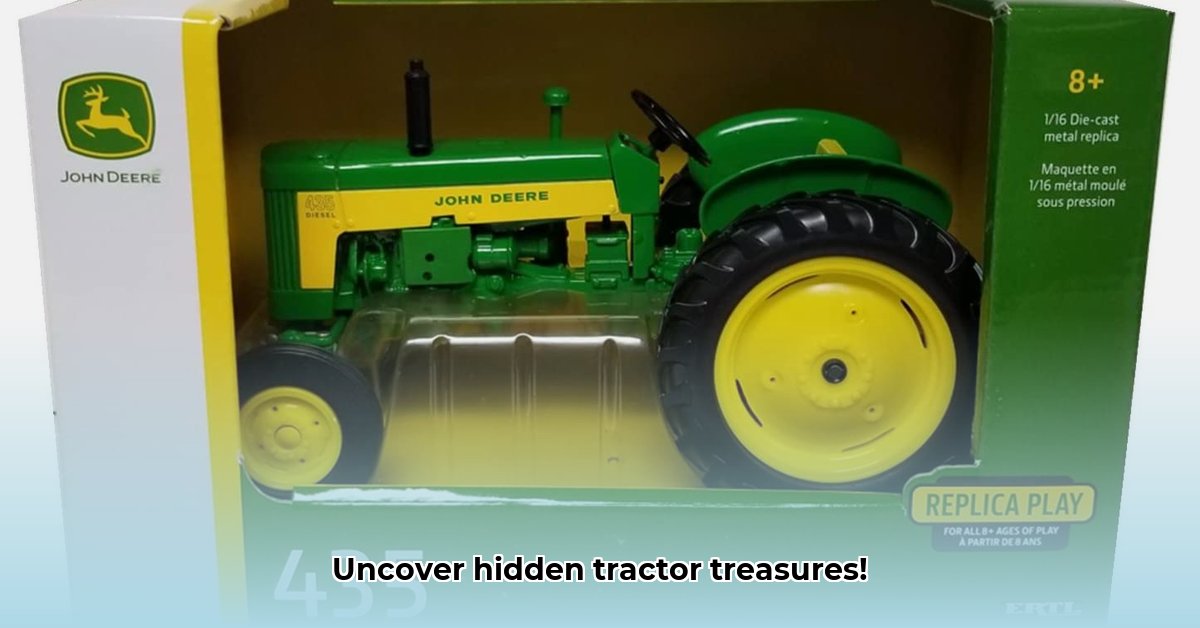
Toy Tractor Metal: A Collector's Guide to Tiny Titans
The world of collectible toy tractors is surprisingly vast and captivating. For many, it’s more than a hobby; it’s a journey into nostalgia, a celebration of craftsmanship, and even a potential investment. But where do you start? This guide will help you navigate the field, whether you're a seasoned collector or just beginning your collecting journey. For more on specific brands, check out this guide to New Holland tractors.
The Enduring Appeal of Miniature Farm Friends
Why are these little metal marvels so captivating? It's a confluence of factors. For many, it's the powerful surge of childhood memories – the joy of playing with these miniature farming icons, pushing them across the floor, creating imaginary farms. But the appeal extends beyond nostalgia. These aren't just toys; they're meticulously crafted miniature works of art. Notice the detail: the vibrant colors, often perfectly replicating real-life counterparts; the satisfying weight of the metal in your hand. Each tiny tractor embodies a piece of history, a testament to a bygone era of simpler toys and imaginative play.
Do you recall the feeling of owning your first toy tractor? What made it special? Many collectors find themselves drawn to specific models because of their resemblance to tractors used by family members, creating a powerful emotional connection.
Spotting a Star: Identifying Valuable Toy Tractors
Several key factors determine a toy tractor's value and desirability.
- Rarity is Key: Limited editions and discontinued models are the holy grails. The scarcer the item, the more valuable it becomes. These are the tractors collectors actively seek.
- Condition Counts: A pristine toy tractor is worth significantly more than a well-loved one. Think of it like a classic car: mint condition commands a premium.
- Brand Matters: Manufacturers like Ertl and Matchbox have built strong reputations. These brands command higher prices due to their history and craftsmanship.
- Unique Traits Boost Value: Unusual designs, paint schemes, or accessories (like miniature plows) increase value. It's often the small details that make a big difference.
Building Your Dream Fleet: A Collector's Roadmap
Starting a collection can be both exciting and daunting. These steps will help you build your collection strategically:
- Budget Wisely: Start small and gradually expand. Don't feel pressured to overspend.
- Focus Your Search: Specialize in a particular brand, scale (1:64 or 1:16), or era of tractor design. This makes collecting more manageable.
- Become a Toy Tractor Expert: Research manufacturers, models, and values using online resources and collector communities. Knowledge is power.
- Inspect Thoroughly Before You Buy: Examine the paint, wheels, and moving parts for damage. A careful inspection is crucial.
- Join the Community: Connect with other enthusiasts to gain knowledge and find rare treasures.
Where the Treasures Hide: Hunting Grounds for Collectors
Online marketplaces like eBay are great resources, but don't overlook brick-and-mortar stores. Antique shops, flea markets, and garage sales can yield unexpected treasures. The thrill of the hunt enhances the collecting experience.
The Future of the Hobby: Looking Ahead
The market for collectible toy tractors shows consistent growth, fueled by nostalgia and dwindling supplies of older models. What factors might influence the long-term value of these collectibles? While experts predict continued growth, some believe certain segments may become saturated. The interplay of supply, demand, and collector interest will shape the future of this exciting hobby.
Is It an Investment? Weighing the Pros and Cons
While not everyone collects for investment, the potential for significant returns exists. Remember, this is a long-term game requiring patience, knowledge, and a bit of luck.
| Factor | Advantages | Disadvantages |
|---|---|---|
| Condition | Pristine condition commands premium prices. | Damage significantly diminishes value. |
| Rarity | Rare models appreciate in value. | Common models may not appreciate significantly. |
| Brand Recognition | Well-known brands maintain their value. | Lesser-known brands have unpredictable value growth. |
| Original Packaging | Original boxes and inserts substantially increase value. | Missing packaging drastically reduces value. |
How to Identify Rare Collectible Metal Toy Tractors
The world of antique metal toy tractors is a fascinating blend of history, craftsmanship, and potential riches. Here's how to spot a true gem:
Manufacturer Matters: A Brand's Legacy
Established brands like Arcade, Hubley, and Ertl command higher prices due to their established reputations. Researching these manufacturers and their production histories is a crucial step. Did you know that certain manufacturers used specific paint types or casting techniques that aid identification? This detail can significantly boost a tractor's valuation.
The Age Factor: Time's Telltale Signs
Age is a key indicator. Tractors from the 1920s-1940s are highly sought after, but condition is equally vital.
Condition is King: Assessing the State of Your Find
Even a rare tractor in poor condition is less valuable. Examine the paint, wheels, and accessories carefully. What are some common signs of wear and tear to watch out for in vintage toy tractors? Meticulous preservation directly impacts value.
Scale and Size: The Significance of Specificity
Unusual scales can enhance value. Compare the size to similar models.
Details, Details, Details: Recognizing Authentic Features
Spotting fakes is crucial. Examine paint application, casting quality, and accessories for authenticity.
Leveraging Resources: Harnessing the Power of Information
Online marketplaces, collector forums, and price guides offer valuable data and expert opinions. Don't hesitate to seek advice from experienced collectors.
Key Takeaways:
- Manufacturer reputation heavily influences value.
- Older tractors often command higher prices.
- Exceptional condition is paramount.
- Unusual scale or size can add rarity.
- Authentic features and accessories are key identifiers.
- Use online resources and collector communities for guidance.